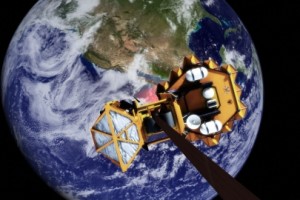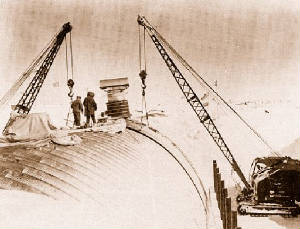In 2009 a helicopter hovered 900m above the Mojave Desert, Andrew Petro was watching. Dangling from the helicopter was a tethered steel cable and a tripod-mounted laser. As Mr Petro watched a small, square robotic device rose upwards, powered by the laser; its ascension was smooth and rapid along the cable, 600 metres up it slowed and stopped. On behalf of NASA, Andrew Petro handed the semi-successful team behind the robotic square a cheque for $900,000 – they had just won a competition about the future of space travel.
Getting to space is expensive, but it becomes a lot cheaper when you don’t use rocket fuel. How to escape the planet without using rocket fuel has been a bit of a conundrum though, but we are approaching the answer steadily. The answer involves a powerful laser, a cable long enough to wrap around earth 8 times, a large steel ball and finally a very big metal box.
First described in 1895 as a ‘celestial castle’ attached to earth by a tether on the top of something like the Eiffel tower. It was more accurately presented in 1979 by Arthur C. Clarke’s ‘The Fountains of Paradise.’ The answer is a Space Elevator.
The competition was the 2009 Space Elevator Games, a NASA-run competition to encourage innovation into prototype space elevators. The reasons for the sudden interest and investment from NASA are two-fold. Firstly in 1990 the first carbon nanotubes were successfully manufactured; and secondly, high-strength lasers are rapidly increasing in power. The thing is becoming possible. So now, it seems, the space elevator concept could finally be getting off the ground.
The concept is this: out in space is a large steel ball, attached to this is a tether which spans some 100,000 kilometres to Earth. As Earth spins around, the steel ball tries to fly off into space but is held back by tension in the tether, this pulling between the tether and the steel ball keeps the tether taut. On the tether is an elevator bearing loads, or loads of people. It then proceeds to elevate them in the same way as a ski lift, a series of rollers against the tether spin and pull the elevator up.
It is quite simply a revolution, once built the elevator could carry goods, equipment and people to space for the cost of providing electricity. It would allow for things such as orbital solar farms which people could go up and repair themselves. Visiting space would be easier, and much cheaper, and that’s only domestic. The problem is that very little of what has been said so far is possible. Yet.
Impossible thing number 1 is the tether, it would need to support its own weight plus around 20 metric tons of space-bound goods. Only one material can handle those stresses, carbon nanotubes; 180 times stronger than steel and much lighter. To get an elevator to space would require a single cable only 6.5 millimetres across. Something too difficult to make today, but many expect it to become possible in the next 20 years. The Spaceward Foundation says it would be a:
“thin black line, almost like the trace of a film-scratch on a picture. The tether reaches straight up and quickly disappears from view into the clear blue sky.”
Impossible thing number 2 is power. If you used batteries, you would not get enough power out of them to lift their own weight. So the solution is power beaming. This means firing a big laser at a big solar cell on the elevator. This, and power from the sun allows the elevator to elevate. We just need more powerful, more reliable and more efficient lasers.
 Impractical would be the most appropriate word at the moment, however hope is at hand. Progress must go on, for that is the definition of progress. In addition to NASA, the Japanese Space Agency, JAXA, is looking into developing their own large prototype. The Spaceward Foundation expects at least one Space Elevator to be functional by 2025, with a commercial, possibly even tourist one in place by 2035.
Impractical would be the most appropriate word at the moment, however hope is at hand. Progress must go on, for that is the definition of progress. In addition to NASA, the Japanese Space Agency, JAXA, is looking into developing their own large prototype. The Spaceward Foundation expects at least one Space Elevator to be functional by 2025, with a commercial, possibly even tourist one in place by 2035.
The expected journey is several days long but would be a sedate affair as the elevator slowly rises. Well technically the elevator doesn’t rise, it is falling, upwards. On Earth it will be upside down, and in space it will be the right way up, but that shouldn’t matter.
There are grand plans for the elevator, the Spaceward Foundation predicts the first Space elevator will mainly carry up parts for the first zero gravity factories for nano-machines and space hotels where space tourists shall enjoy their space holidays, in space. Also they see another use.
You have a space elevator, spinning around the Earth attached to the end of a tether, what happens when it is released?
If done accidentally it would be a new kind of problem, but if you aimed, the whole system would fly out into space, maybe heading for the Moon, or Mars perhaps. Suddenly we have a safe and cheap, if rather slow method of space travel.
Settlers with their belongings arrive in a large corporate building. They file into a large, cylindrical chamber and the select their seats. Farewells dealt with they settle down and one person reaches for the buttons. A wandering finger passes by the numbers and pauses, before firmly prodding the button labelled ‘Space.’ A slight whirr and they set off upwards, first out of the rather tall building, past the clouds and Earth, coasting on top of a laser.
When they reach the end of their tether they simply let go of Earth and are flung into space. Several weeks later they step, rather ruffled, out of the crash-landed elevator and onto Mars. Among them, a confused office worker who got into the wrong lift.
Of course this would not happen, current proposals suggest the base building for the tether would be 50km high. The rest, may be accurate. With the push of a button and the firing of a laser you could reach space. So removed from the spectacle and furore of a rocket launch that it is a wonder they lead to the same place. The appeal of the idea is that it would be both safe and easy, a combination which lifts the spirit.
Space would finally seem not just possible, but attainable. Then perhaps we could all gaze down at the blue marble of the earth, stretched out beneath our feet. Space would become a place, not just a concept.
Just don’t expect to spot the ‘Space’ button in an elevator any time soon.
Further Reading:
NASA article on the 2009 Space Elevator Games
NASA article on the Space Elevator concept


